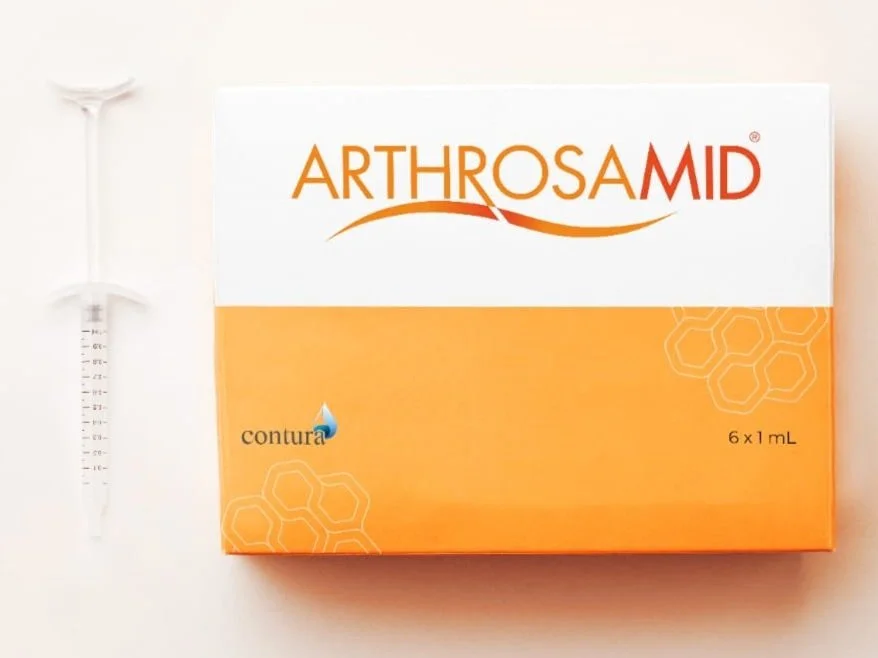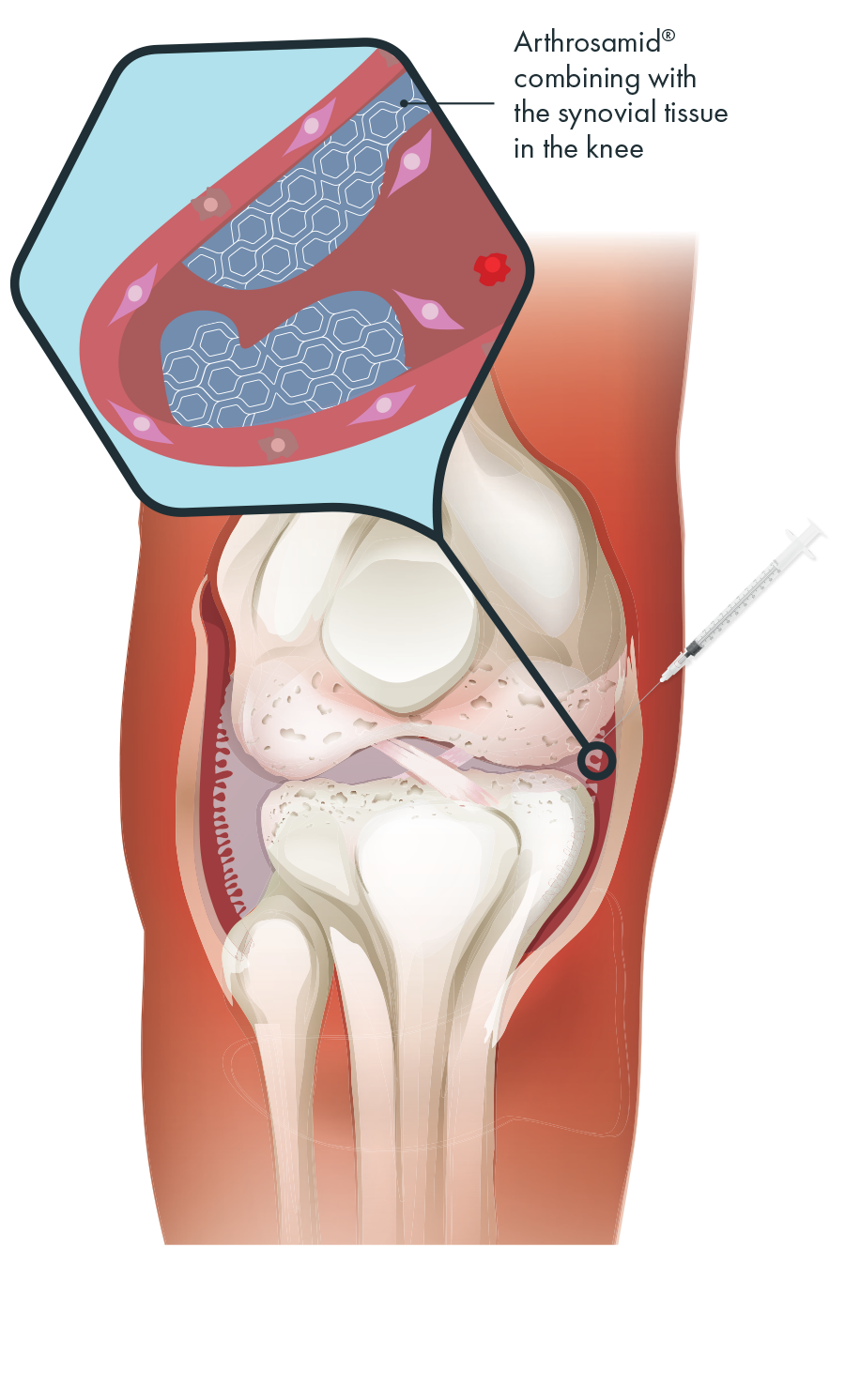Arthrosamid Injections for Knee Arthritis: Long-Lasting Pain Relief
Knee osteoarthritis (OA) is a long-term, degenerative joint condition where the protective cartilage cushioning the bones wears down. As the cartilage deteriorates, bones begin to rub against each other, leading to stiffness, swelling, reduced mobility, and persistent pain. Over time, the condition worsens and becomes a significant cause of disability, especially in older adults.
Despite being the most common form of arthritis and the fastest-growing cause of disability worldwide, treatment options for knee OA have remained relatively unchanged for decades. Most therapies aim to manage pain rather than address the root of the problem — and a permanent cure remains elusive.
What is Arthrosamid?
Arthrosamid is a revolutionary injectable hydrogel designed to break the cycle of synovial pain in knee OA. It’s a non-surgical, long-acting treatment that provides clinically proven pain relief and improved joint function — with results lasting up to 5 years after a single injection.
Unlike temporary solutions like hyaluronic acid (HA) injections, Arthrosamid permanently integrates into the knee’s synovial lining, enhancing the tissue’s elasticity and reducing inflammation and pain.
The Role of Synovial Pain in Knee OA
Synovial pain (or synovitis) occurs when the synovial tissue — the soft lining of the joint — becomes inflamed. This inflammation is not only painful but also contributes to further cartilage damage, creating a vicious cycle:
Inflammation triggers immune cells.
These cells release enzymes that break down cartilage.
The joint fails to heal properly.
More damage occurs, and the cycle continues.
Over time, this leads to progressive joint degeneration and worsening of symptoms.
How Does Arthrosamid Work?
After being injected directly into the knee joint (typically under local anaesthesia), Arthrosamid® disperses into the synovial fluid and bonds with the synovial tissue. Within 6–12 weeks, it fully integrates with the joint lining, helping:
Decrease stiffness
Reduce pain
Improve knee function
Enhance overall mobility
It’s a one-step, outpatient procedure with minimal downtime — no hospital stay, no general anaesthesia, and no lengthy recovery.
How is Arthrosamid Administered?
Before the injection, a local anaesthetic is administered to numb the area around the knee.
Antibiotics are given prior to the procedure to reduce the risk of infection.
The knee area is cleaned thoroughly before the injection.
Arthrosamid® is injected directly into the synovial cavity of the knee.
The procedure may be guided by ultrasound to ensure accurate placement.
After injection, the needle is removed, and a plaster is applied to the injection site.
Once inside the joint, Arthrosamid® disperses within the synovial fluid.
It begins to adhere to and integrate with the synovial tissue, forming a mesh-like structure that helps cushion and protect the joint.
Benefits of Arthrosamid
Provides long-lasting pain relief (up to 5 years)
Improves knee joint function and mobility
Reduces stiffness and inflammation
Single, non-surgical injection
Outpatient procedure with minimal downtime
High patient satisfaction rates
Effective even when other treatments fail (like HA injections or physical therapy)
Backed by over 20 years of research
Safe for long-term use with no cumulative side effects
Suitable for elderly or surgical high-risk patients
Backed by Research and Real-World Results
Arthrosamid® is supported by over 20 years of research and has demonstrated reproducible results in multiple clinical studies. Patients show significant improvements on the WOMAC pain scale — often exceeding the minimum clinically important difference (MCID) of -9, with benefits lasting up to 5 years post-treatment.
“After just one week, I was able to walk more normally again. Pain was reduced by 90%. I have my life back again.” – Lorraine, age 60
“I was facing knee replacement surgery, but Arthrosamid® changed everything. I’m back on the court.” – Paul, age 51
Who Is Arthrosamid For?
Arthrosamid is suitable for most adults with symptomatic knee OA — especially those who:
Aren’t ready or eligible for surgery
Want to avoid the side effects and recovery of invasive procedures
Haven’t found relief through conventional therapies (weight loss, bracing, physiotherapy, or oral medications)
Studies show that up to 80% of patients under age 70 report a positive response to Arthrosamid®, with similar success in older adults.
Why Arthrosamid Stands Out
Long-lasting pain relief from a single injection
Non-surgical, outpatient procedure
Clinically proven improvement in joint function
Safe and effective for a wide range of patients
Maintains results up to five years
Minimal side effects and no hospital stay
Side Effects of Arthrosamid
Mild joint pain post-injection
Temporary sensation of joint swelling
Localized discomfort at injection site
Rare: mild inflammation or fluid build-up in the joint
Typically short-term and self-limiting (lasting a few days to weeks)
No serious adverse events reported in studies
Contraindications of Arthrosamid
Active infection in the knee joint or surrounding area
Known allergy to polyacrylamide or any component of the product
Current or recent skin disease or rash near the injection site
Severe immune suppression or autoimmune disorders (assessed case-by-case)
Recent knee surgery (wait period may be required)
Advanced bone-on-bone osteoarthritis (effectiveness may be reduced)
Not recommended during pregnancy or breastfeeding (lack of data)
Not for patients with significant joint instability or mechanical derangement
Conclusion:
Arthrosamid injections offer a safe, effective, and long-lasting solution for managing knee osteoarthritis. By providing enhanced joint lubrication and acting as a cushion within the knee, Arthrosamid reduces pain, improves mobility, and helps patients avoid more invasive treatments like surgery.
With its minimally invasive nature and the ability to offer up to two years of relief, Arthrosamid is a game-changing option for individuals suffering from knee osteoarthritis, particularly those looking for a non-surgical solution. The use of ultrasound guidance ensures precise placement of the injection, enhancing both safety and effectiveness.
By choosing Arthrosamid, patients can experience long-term pain relief and an improved quality of life, allowing them to maintain active lifestyles without the need for more complex interventions. Early treatment with Arthrosamid can help delay the need for knee replacement surgery and offer a more personalized, proactive approach to managing osteoarthritis.
References:
Bliddal, H., et al. (2024). Three-year follow-up from a randomized controlled trial of intra-articular polyacrylamide hydrogel injection in subjects with knee osteoarthritis. Osteoarthritis and Cartilage, 32(6), 770–771.
Bliddal, H., et al. (2025). A prospective study of polyacrylamide hydrogel injection for knee osteoarthritis: Results from 5 years after treatment. Presented at WCO-IOF-ESCEO 2025.
Neogi, T. (2013). The epidemiology and impact of pain in osteoarthritis. Osteoarthritis and Cartilage, 21(9), 1145–1153. https://doi.org/10.1016/j.joca.2013.03.018
Thomson, A., et al. (2021). Synovial macrophages in osteoarthritis: The key to understanding pathogenesis? Frontiers in Immunology, 12, 678757.
Mathiessen, A., & Conaghan, P. G. (2017). Synovitis in osteoarthritis: current understanding with therapeutic implications. Arthritis Research & Therapy, 19(1), 18.
Baker, K., et al. (2010). Relation of synovitis to knee pain using contrast-enhanced MRIs. Annals of the Rheumatic Diseases, 69(10), 1779–1783. https://doi.org/10.1136/ard.2009.120220
Data on file.
Torres, L., et al. (2006). The relationship between specific tissue lesions and pain severity in persons with knee osteoarthritis. Osteoarthritis and Cartilage, 14(10), 1033–1040.
Christensen, L., et al. (2016). Histological appearance of the synovial membrane after treatment of knee osteoarthritis with polyacrylamide gel injections: A case report. Journal of Arthritis, 5, 217.
Bliddal, H., et al. (2021). Polyacrylamide hydrogel injection for knee osteoarthritis: A 6 months prospective study. Journal of Orthopaedic Research and Therapy, 6(2), 1188.
Bliddal, H., et al. (2024). Polyacrylamide gel versus hyaluronic acid for the treatment of knee osteoarthritis: A randomised controlled study. Clinical and Experimental Rheumatology, 42(9), 1729–1735.
Contura International. (2022). Arthrosamid®: Instructions for use (10082-003).
Bliddal, H., et al. (2024). Effectiveness and safety of polyacrylamide hydrogel injection for knee osteoarthritis: Results from a 12-month follow up of an open-label study. Journal of Orthopaedic Surgery and Research, 19, 274.
Henriksen, M., et al. (2018). Intra-articular 2.5% polyacrylamide hydrogel for the treatment of knee osteoarthritis: An observational proof-of-concept cohort study. Clinical and Experimental Rheumatology, 36(6), 1082–1085.
Bliddal, H., et al. (2024). Polyacrylamide hydrogel for knee osteoarthritis: Four-year results from a prospective study. Orthopaedic Proceedings, 106-B(Suppl_18), 106.
Grässel, S., & Muschter, D. (2020). Recent advances in the treatment of osteoarthritis. F1000Research, 9, F1000 Faculty Rev–325.
Bliddal, H., et al. (2022). A prospective study of polyacrylamide hydrogel injection for knee osteoarthritis: Results from 2 years after treatment. Poster presented at OARSI 2022. Osteoarthritis and Cartilage, 30(1), S371–S372.
Bliddal, H., et al. (2023). A prospective study of polyacrylamide hydrogel injection for knee osteoarthritis: Results from 3 years after treatment. Osteoarthritis and Cartilage, 31(5), 682–683.
Trigkilidas, D., et al. (2013). The effectiveness of hyaluronic acid intra-articular injections in managing osteoarthritic knee pain. Annals of the Royal College of Surgeons of England, 95, 545–551.
Overgaard, A., et al. (2019). Safety of intra-articular polyacrylamide hydrogel for the treatment of knee osteoarthritis symptoms: A retrospective case series. Osteoarthritis and Cartilage, 30(1), S370–S371.







